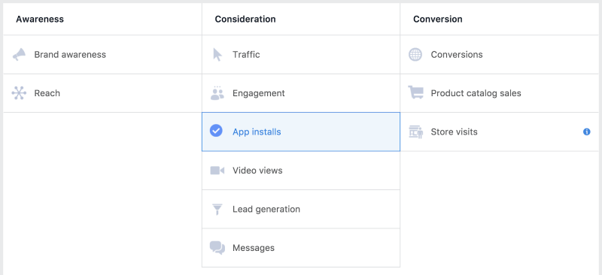With its vast user base and impressive range of targeting options, it’s hardly surprising that brands turn to Facebook when looking to promote their products and services. As of June 30, 2022, Facebook received 2.93 billion monthly active users, making it the world’s most frequently visited social media platform, followed by YouTube, WhatsApp and Instagram.
There are a number of ad formats that you can use on Facebook, from image ads and instant experience ads to carousel ads and video ads. Facebook video ads are a fun, cost-effective way to inspire action from your prospects: a study conducted by Databox has shown that video ads outperform image ads in terms of driving engagement and conversions on Facebook.
Let’s take a look at how to create video ads for Facebook that attract leads and add a little buzz to your brand.
Identify an appropriate objective
There are 11 ad campaign objectives that you can choose from for your video ads; these include app installs (selected below), catalogue sales and store visits.
Facebook recommends that you use the Brand Awareness objective if you would like to show your video to the people who are most likely to remember it, and that you use the Video Views objective if you want to show your video to as many people as possible.
Start the process of creating your Facebook video ad by thinking carefully about what you want your video to accomplish. Bear in mind that your choice of objective will determine the placements that will be available for your video ad.
We recommend that you start by using Facebook’s automatic placement setting; this will display your video across all of the available placements. Once you have sufficient data, you may decide to make a manual adjustment based on which placements, i.e. the News Feed, In-stream video, Instant Articles, etc. are driving the best results.
Optimise your Facebook video ads for mobile
You’d be mad not to make video ads with the mighty mobile in mind. 98.5% of users choose to access Facebook via mobile, and critically, 81.8% only access Facebook via their mobile devices. Unfortunately, this makes things a little trickier: Facebook data has revealed that people spend, on average, just 1.7 seconds with a piece of content that appears on their news feeds on mobile, compared to 2.5 seconds on desktop.
It is recommended, therefore, that you aim for a video length of 15 seconds or less. Video ads of this duration are more likely to hold people’s attention, and they are also eligible to appear in Facebook in-stream placements and Instagram Stories.
Include the most compelling part of your video within the first three seconds, and try to showcase either your brand or product within the first five. This may sound like a tall order, but you’d be surprised by just how much information you can convey to your viewers if you put your mind to it.
We also advise that you opt for a vertical (4:5) or square (1:1) aspect ratio, given that people tend to hold their phones vertically. The 4:5 vertical video ad format is the sweet spot here, as it works well on both Facebook and Instagram.
Our FB ads for Mackies are a good example of how eye-catching imagery and prominent branding (delivered in a square format, no less) can help increase brand awareness.
Finally, convey the key pieces of dialogue with subtitles; mobile users often choose to watch video with the sound off, and they prefer to watch videos that include captions.
Use Facebook’s hyper-specific targeting tools
Facebook aims to display ads that are relevant to its users, as they benefit from receiving content that is tailored to their hobbies and interests. Advertisers also stand to benefit enormously by using Facebook’s ad targeting settings.
Before you start creating target audiences, put together some buyer personas based on what you already know about your existing customers. How old are they? Are they predominantly male or female? What do they enjoy doing in their free time?
You can then start to identify your audience segments. Whilst age and gender are important, you will achieve the best results if you target users based on interests that are relevant to your brand. And there are thousands of interests to choose from!
The targeting strategy that you adopt should relate to the objective that you identified at the outset. Displaying your videos to a broad audience often works best for brand awareness campaigns, as opposed to conversion-oriented ads.
You should be more specific, however, if you wish to drive conversions. With layered targeting, you can direct your video ads at specific demographic, e.g. male, aged 45-65, married with children, etc. and psychographic segments, e.g. enjoys classical music, watches Test cricket and supports the monarchy.
Opting for granular targeting will mean that your Facebook video ads are shown to the sorts of people who will be most interested in what you have to offer – which means better results and lower costs.
Remember to include a CTA button
As a final word of advice, always include a call-to-action button alongside your Facebook video ad.
The call-to-action that you choose should align with the objective of your campaign, whether it is to encourage people to learn more or shop now.
You’re now ready to create Facebook video ads
We hope that this has provided you with plenty of inspiration – or at the very least, food for thought – with regard to making effective Facebook video ads.
Find out more about eCommerce video ads and how you can use video in your social media ads today.
Small Films is a video production company in London. Our team of videographers, editors and animators create all sorts of videos, including awesome product videos, testimonial videos, explainer videos and animations that can help bring your brand to life. Do get in touch; we’d love to hear from you!





